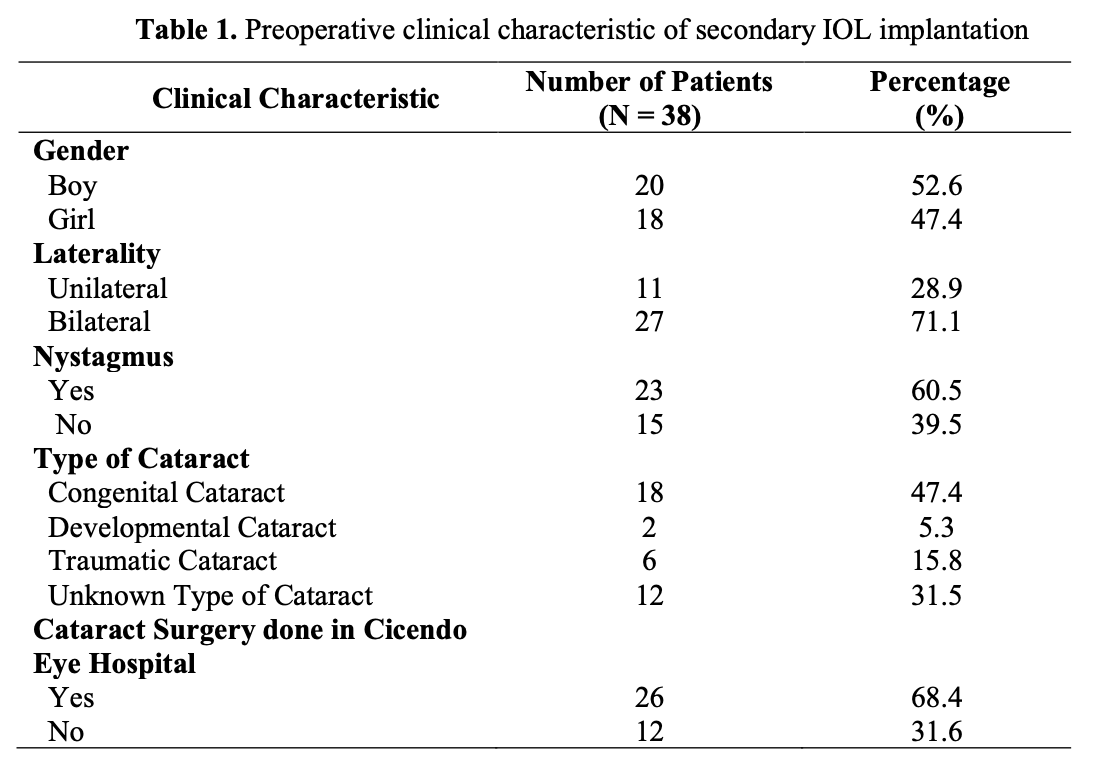VISUAL OUTCOMES AND COMPLICATIONS OF IRIS-CLAW INTRAOCULAR LENS IMPLANTATION IN APHAKIC EYES WITH INADEQUATE CAPSULAR SUPPORT
Abstract
Introduction: Aphakia with inadequate capsular support remains a challenge for ophthalmologist. Although there is no consensus on the best method for this case, many studies have been reported using iris claw intraocular lens for secondary implantation.
Objective: To evaluate the various indications, visual outcomes, and complications of iris claw intraocular lens in aphakic eyes.
Methods : This retrospective case study was conducted in Undaan Eye Hospital, Surabaya, collecting data from medical records with a total of 188 eyes of 186 patients between May 2017 and April 2020, that were rehabilitated with prepupillary and retropupillary fixation of an iris claw lens. Patients were followed-up to 9 months for visual acuity and complications.
Results: The most common cause of aphakia was subluxation of lens (spontaneous, trauma or congenital) in 90 of the 188 eyes (47.3%). The mean follow-up was 3 months (range :1-9 month). Most patient had the best preoperative BCVA (0-0.50 logMAR) 63%, ranging 0-2.47 logMAR with a mean of 0.72 logMAR. At final follow up, of the total patients, 72.9 % had the BCVA of 0-0.5 logMAR, with a mean of 0.37 logMAR. Complication included secondary glaucoma 2.12%, uveitis 1.06 %, iridodyalisis 1.06 %, and bullous keratopathy 1.06%.
Conclusion: iris claw IOL implantation is a safe and effective method of rehabilitating aphakic eye with inadequate capsular support.
Full text article
References
Lett KS, Chaudhuri PR. Visual outcomes following Artisan aphakia iris claw lens implantation. Eye. 2011 Jan;25(1):73–6. https://pubmed.ncbi.nlm.nih.gov/20948556/
Hazar L, Kara N, Bozkurt E, Ozgurhan EB, Demirok A. Intraocular Lens Implantation Procedures in Aphakic Eyes With Insufficient Capsular Support Associated With Previous Cataract Surgery. J Refract Surg. 2013 Oct 1;29(10):685–91. https://pubmed.ncbi.nlm.nih.gov/23898947/
El-Saadany A-KI, Khairy HA, Rajab GZ, Fayed AMS. The use of iris claw intraocular lens in aphakic eyes with inadequate capsular support and in phakic eyes for correction of high refractive errors. :10. https://www.djo.eg.net/article.asp?issn=11109173;year=2020;volume=21;issue=1;spage=25;epage=34;aula st=El-Saadany
Periyanayagi M, Selvaraj N, Sivakami M. Posterior iris-claw intraocular lens implantation as an effective
option in aphakia. TNOA J Ophthalmic Sci Res. 2017;55(4):282. https://www.tnoajosr.com/article.asp?issn=2589- 4528;year=2017;volume=55;issue=4;spage=282;epage=285;aulast=Periyanayagi
Forlini M, Soliman W, Bratu A, Rossini P, Cavallini GM, Forlini C. Long-term follow-up of retropupillary iris-claw intraocular lens implantation: a retrospective analysis. BMC Ophthalmol. 2015 Dec;15(1):143. https://pubmed.ncbi.nlm.nih.gov/26507387/
Faria M, Pinto Ferreira N, Medeiros Pinto J, Cordeiro-Sousa D, Cardoso-Leal I, Neto E, et al. Retropupillary iris claw intraocular lens implantation in aphakia for dislocated intraocular lens. Int Med Case Rep J. 2016 Aug;Volume 9:261–5. https://www.ncbi.nlm.nih.gov/pmc/articles/PMC5010170/
Ophthalmol Ina 2023;Vol. 49(1):3-9
Jing W, Guanlu L, Qianyin Z, Shuyi L, Fengying H, Jian L, et al. Iris-Claw Intraocular Lens and Scleral- Fixated Posterior Chamber Intraocular Lens Implantations in Correcting Aphakia: A Meta-Analysis. Investig Opthalmology Vis Sci. 2017 Jul 14;58(9):3530. https://pubmed.ncbi.nlm.nih.gov/28715586/
Schallenberg M, Dekowski D, Hahn A, Laube T, Steuhl K-P, Meller D. Aphakia correction with retropupillary fixated iris-claw lens (Artisan) – long-term results. Clin Ophthalmol. 2013 Dec;137. https://pubmed.ncbi.nlm.nih.gov/24391439/
Toro MD, Longo A, Avitabile T, Nowomiejska K, Gagliano C, Tripodi S, et al. Five-year follow-up of secondary iris-claw intraocular lens implantation for the treatment of aphakia: Anterior chamber versus retropupillary implantation. Achiron A, editor. PLOS ONE. 2019 Apr 10;14(4):e0214140. https://pubmed.ncbi.nlm.nih.gov/30970023/
Vounotrypidis E, Schuster I, Mackert MJ, Kook D, Priglinger S, Wolf A. Secondary intraocular lens implantation: a large retrospective analysis. Graefes Arch Clin Exp Ophthalmol. 2019 Jan;257(1):125–34. https://pubmed.ncbi.nlm.nih.gov/30413876/
AnandhiD,SravyaMr.Clinicaloutcomeofiris-clawintraocularlensimplantation.TNOAJOphthalmicSci Res.2019;57(1):3.https://www.tnoajosr.com/article.asp?issn=25894528;year=2019;volume=57;issue=1;spa ge=3;epage=7;aulast=Anandhi
De Silva SR, Arun K, Anandan M, Glover N, Patel CK, Rosen P. Iris-claw intraocular lenses to correct aphakia in the absence of capsule support: J Cataract Refract Surg. 2011 Sep;37(9):1667–72. https://pubmed.ncbi.nlm.nih.gov/21855764/
Jayamadhury G, Potti S, Kumar Kv, Kumar Rm, Divyansh Mishra K, Nambula S. Retropupillary fixation of iris-claw lens in visual rehabilitation of aphakic eyes. Indian J Ophthalmol. 2016;64(10):743. https://journals.lww.com/ijo/fulltext/2016/64100/retropupillary_fixation_of_iris_claw_lens_in.9.aspx
Authors
Copyright (c) 2023 Faiz Nurboston Fauzi, Dini Dharmawidiarini, Farida Moenir, Sahata PH Napitupulu

This work is licensed under a Creative Commons Attribution-NonCommercial-ShareAlike 4.0 International License.


